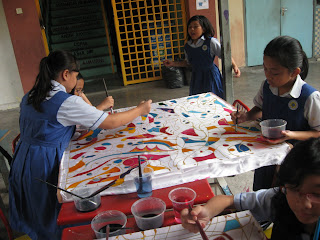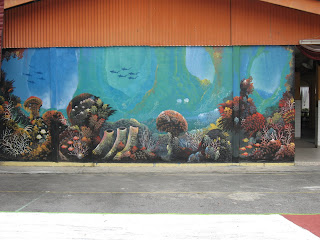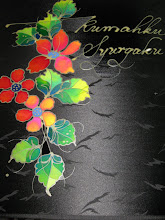Batik Introduction
Batik (Javanese pronunciation: [ˈbate?]; Indonesian pronunciation: [ˈbaːtik]; English: /ˈbætɪk/ or /bəˈtiːk/) is a cloth which traditionally uses a manual wax-resist dyeing technique. Due to modern advances in the textile industry, the term has been extended to include fabrics which incorporate traditional batik patterns even if they are not produced using the wax-resist dyeing techniques. Silk batik is especially popular-
Indonesia have their own unique patterns which normally take themes from everyday lives, incorporating patterns such as flowers, nature, animals, folklore or people. The colours of pesisir batik, from the coastal cities of northern Java, is especially vibrant, and it absorbs influence from the Javanese, Arab, Chinese and Dutch culture. In the colonial times pesisir batik was a favorite of the Peranakan Chinese, Dutch and Eurasians.
Batik or fabrics with the traditional batik patterns are also found in several countries such as Malaysia, Japan, China, Azerbaijan, India, Sri Lanka, Egypt, Nigeria, Senegal, and Singapore. Malaysian batik often displays plants and flowers, as Islam forbid pictures of other living beings.
Etymology
lthough the word's origin is Javanese, its etymology may be either from the Javanese amba ('to write') and titik ('dot' or 'point'), or constructed from a hypothetical Proto-Austronesian root *betík, meaning 'to tattoo' from the use of a needle in the process. The word is first recorded in English in the Encyclopædia Britannica of 1880, in which it is spelled battik. It is attested in the Indonesian Archipelago during the Dutch colonial period in various forms: mbatek, mbatik, batek and batik.
History
Wax-resist dyed textile from Niya (Tarim Basin),ChinaWax resist dyeing technique in fabric is an ancient art form. Discoveries show it already existed in Egypt in the 4th century , where it was used to wrap mummies; linen was soaked in wax, and scratched using a sharp tool. In Asia, the technique was practiced in China during the T'ang dynasty (618-907 CE), and in India and Japan during the Nara period (645-794 CE). In Africa it was originally practiced by the Yoruba tribe in Nigeria, Soninke and Wolof in Senegal.
In Java, Indonesia, batik predates written records. GP. Rouffaer argues that the technique might have been introduced during the 6th or 7th century from India or Sri Lanka.[6] On the other hand, JLA. Brandes (a Dutch archeologist) and F.A. Sutjipto (an Indonesian archeologist) believe Indonesian batik is a native tradition, regions such as Toraja, Flores, Halmahera, and Papua which were not directly influenced by Hinduism have an old age tradition of batik making.
GP. Rouffaer also reported that the gringsing pattern was already known by the 12th century in Kediri, East Java. He concluded that such a delicate pattern could only be created by means of the canting (also spelled tjanting or tjunting; IPA: [tʃantɪŋ]) tool. He proposed that the canting was invented in Java around that time.
Batik was mentioned in the 17th century Malay Annals. The legend goes when Laksamana Hang Nadim was ordered by Sultan Mahmud to sail to India to get 140 pieces of serasah cloth (batik) with 40 types of flowers depicted on each. Unable to find any that fulfilled the requirements explained to him, he made up his own. On his return unfortunately, his ship sank and he only managed to bring four pieces, earning displeasure from the Sultan.
In Europe, the technique is described for the first time in the History of Java, published in London in 1817 by Sir Thomas Stamford Raffles who had been a British governor for the island. In 1873 the Dutch merchant Van Rijckevorsel gave the pieces he collected during a trip to Indonesia to the ethnographic museum in Rotterdam. Today Tropenmuseum housed the biggest collection of Indonesian batik in the Netherlands. The Dutch were active in developing batik in the colonial era, they introduced new innovations and prints. And it was indeed starting from the early 19th century that the art of batik really grew finer and reached its golden period. Exposed to the Exposition Universelle at Paris in 1900, the Indonesian batik impressed the public and the artisans.[6] After the independence of Indonesia and the decline of the Dutch textile industry, the Dutch batik production was lost, the Gemeentemuseum, Den Haag contains artifacts from that era.
Due globalization and industrialization, which introduced automated techniques, new breeds of batik, known as batik cap (IPA: [tʃap]) and batik print emerged, and the traditional batik which incorporates the hand written wax-resist dyeing technique is known now as batik tulis (lit: 'Written Batik'). At the same time Indonesian immigrants to Malaysia and Singapore brought Indonesian batik with them.
Culture
In one form or another, batik has worldwide popularity. Now, not only is batik used as a material to clothe the human body, its uses also include furnishing fabrics, heavy canvas wall hangings, tablecloths and household accessories. Batik techniques are used by famous artists to create batik paintings which grace many homes and offices.
Indonesia
The Javanese aristocrats R.A. Kartini in kebaya and her husband.Her skirt is of batik, with the parang pattern which was for aristocrats. Her husband is wearing a blangkonDepending on the quality of the art work, dyes, and fabric, the finest batik tulis halus cloth can fetch several thousand dollars, reflecting the fact that it probably took several months to make. Batik tulis has both sides of the cloth ornamented.
In Indonesia, traditionally, batik was sold in 2.25-meter lengths used for kain panjang or sarong for kebaya dress. It can also be worn by wrapping it around the body, or made into a hat known as blangkon. Infants are carried in batik slings decorated with symbols designed to bring the child luck. Certain batik designs are reserved for brides and bridegrooms, as well as their families. The dead are shrouded in funerary batik.Other designs are reserved for the Sultan and his family or their attendants. A person's rank could be determined by the pattern of the batik he or she wore.
Sacred Dance of Bedhoyo Ketawang. The batik is wrapped around the bodyFor special occasions, batik was formerly decorated with gold leaf or dust. This cloth is known as prada (a Javanese word for gold) cloth. Gold decorated cloth is still made today; however, gold paint has replaced gold dust and leaf.
Batik garments play a central role in certain rituals, such as the ceremonial casting of royal batik into a volcano. In the Javanese naloni mitoni "first pregnancy" ceremony, the mother-to-be is wrapped in seven layers of batik, wishing her good things. Batik is also prominent in the tedak siten ceremony when a child touches the earth for the first time. Batik is also part of the labuhan ceremony when people gather at a beach to throw their problems away into the sea.
Contemporary batik, while owing much to the past, is markedly different from the more traditional and formal styles. For example, the artist may use etching, discharge dyeing, stencils, different tools for waxing and dyeing, wax recipes with different resist values and work with silk, cotton, wool, leather, paper or even wood and ceramics. The wide diversity of patterns reflects a variety of influences, ranging from Arabic calligraphy, European bouquets and Chinese phoenixes to Japanese cherry blossoms and Indian or Persian peacocks.
In Indonesia, batik popularity has its up and downs. Historically it was essential for ceremonial costumes and it was worn as part of a kebaya dress, which was commonly worn every day. According to Professor Michael Hitchcock of the University of Chichester (UK), batik "has a strong political dimension. The batik shirt was invented as a formal non-Western shirt for men in Indonesia in the 1960s.It waned from the 1960s onwards, because more and more women chose western clothes. However, batik clothing has revived somewhat in the 21st century, due to the effort of Indonesian fashion designers to innovate the kebaya by incorporating new colors, fabrics, and patterns. Batik is a fashion item for many young people in Indonesia, such as a shirt, dress, or scarf for casual wear. For a formal occasion, a kebaya is standard for women. It is also acceptable for men to wear batik in the office or as a replacement for jacket-and-tie at certain receptions.
Malaysia, Singapore, Brunei, and Thailand
Batik is often worn in Malaysia, Singapore, Brunei, and southern Thailand brought there by Indonesian immigrants or merchants in the 19th century. Malaysian batik can be found on the east cost of Malaysia such as Kelantan, Terengganu and Pahang, while batik in Johor clearly shows Javanese and Sumatran influences since there is a lot of Javanese and Sumatran immigrants in southern Malaysia. The most popular motifs are leaves and flowers. Malaysian batik never depicting humans or animals because Islamic norms forbid anthropomorph and animal images as decoration. However, the butterfly theme is a common exception. The Malaysian batik is also famous for its geometrical designs, such as spirals. The method of Malaysian batik making also quite different than those of Indonesian Javanese batik, the pattern is larger and simpler, it seldom or never uses canting to create intricate patterns and rely heavily on brush painting method to apply colors on fabrics. The colors also tends to be more light and vibrant than deep colored Javanese batik.
The flight attendants of Indonesian, Singaporean, and Malaysian national airlines all wear batik in their uniform. Batik sarongs are also designed as wraps for casual beachwear.
In the southern of Thailand island of Koh Samui, batik is easily found in the form of the resort uniforms, or decorations at many places, and is also the locals casual wear in the forms of sarongs or shirts and blouses, and is the most common, or even one of the symbolic products for the ones whom travels to the Koh Samui Island. The Batik of Samui is mostly showing the beauty and attractions of the paradise island and its culture, such as the coconut shells, the beaches, palm trees, the islands tropical flowers, fishing boats, its rich water life and southern dancer, Papthalung.
Azerbaijan
batik pattern can be found in its women's silk scarves, known as kelagai, which have been part of women's clothing there for centuries. Kelagai were first produced in the village of Basgal and were created using the stamping method and natural colors. The cocoons were traditionally processed by women while the hand-printing with hot wax was only entrusted to male artists. The silk spinning and production of kelagai in Azerbaijan slumped after the fall of the USSR. It was the Inkishaf Scientific Center which revived kelagai in the country. Kelagai is worn by women both old and young. Young women prefer bright colors, while older women wear dark colors.
China
Batik is done by the ethnic people in Guizhou Province, in the South-West of China. The Miao, Bouyei and Gejia people use a dye resist method for their traditional costumes. The traditional costumes are made up of decorative fabrics which they achieve by pattern weaving and wax resist. Almost all the Miao decorate hemp and cotton by applying hot wax then dipping the cloth in an indigo dye. The cloth is then used for skirts, panels on jackets, aprons and baby carriers. Like the Javanese, their traditional patterns also contain symbolism, the patterns include the dragon, phoenix, and flowers.
Types and Variations of Batik.
Javanese Kraton Batik (Javanese court Batik)
Batik is the oldest batik tradition known in Java. Also known as Batik Pedalaman (inland batik) in contrast with Batik Pesisiran (coastal batik). This type of batik has earthy color tones such as black, brown, and dark yellow (sogan), sometimes against a white background. The motifs of traditional court batik have symbolic meanings. Some designs are restricted: larger motifs can only be worn by royalty; and certain motifs are not suitable for women, or for specific occasions (e.g., weddings).
The palace courts (keratonan) in two cities in central Java are known for preserving and fostering batik traditions:
Surakarta (Solo City) Batik. Traditional Surakarta court batik is preserved and fostered by the Susuhunan and Mangkunegaran courts. The main areas that produce Solo batik are the Laweyan and Kauman districts of the city. Solo batik typically has sogan as the background color. Pasar Klewer near the Susuhunan palace is a retail trade center.
Yogyakarta Batik. Traditional Yogya batik is preserved and fostered by the Yogyakarta Sultanate and the Pakualaman court. Usually Yogya Batik has white as the background color. Fine batik is produced at Kampung Taman district. Beringharjo market near Malioboro street is well known as a retail batik trade center in Yogyakarta
Pesisir Batik (Coastal Batik)
Cirebon batik depicting sea creaturesPesisir batik is created and produced by several areas on the northern coast of Java and on Madura. As a consequence of maritime trading, the Pesisir batik tradition was more open to foreign influences in textile design, coloring, and motifs, in contrast to inland batik which was relatively independent of outside influences. For example, Pesisir batik utilizes vivid colors and Chinese motifs such as clouds, phoenix, dragon, qilin, lotus, peony, and floral patterns.
Pekalongan Batik. The most famous Pesisir Batik production area is the town of Pekalongan in Central Java province. Compared to other pesisir batik production centers, the batik production houses in this town is the most thriving. Batik Pekalongan was influenced by both Dutch-European and Chinese motifs, for example the buketan motifs was influenced by European flower bouquet.
Cirebon Batik. Also known as Trusmi Batik because that is the primary production area. The most well known Cirebon batik motif is megamendung (rain cloud) that was used in the former Cirebon kraton. This cloud motif shows Chinese influence.
Lasem Batik. Lasem batik is characterized by a bright red color called abang getih pithik (chicken blood red). Batik Lasem is heavily influenced by Chinese culture.
Tuban Batik. Batik gedog is the speciality of Tuban Batik, the batik was created from handmade tenun (woven) fabrics.
Madura Batik. Madurese Batik displays vibrant colors, such as yellow, red, and green. Madura unique motifs for example pucuk tombak (spear tips), also various flora and fauna images.














